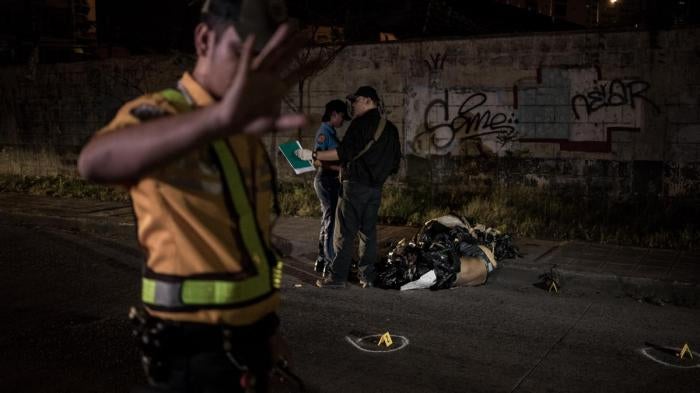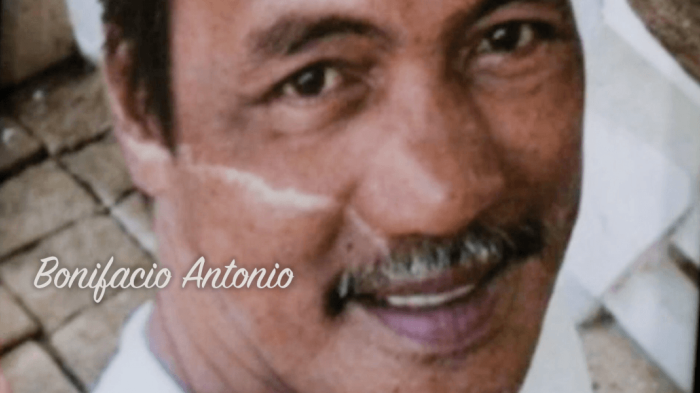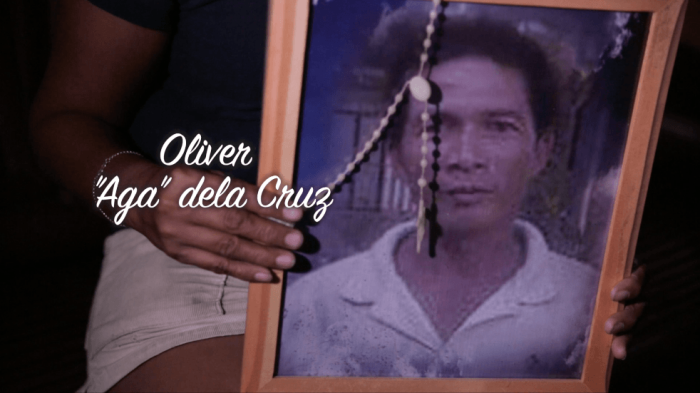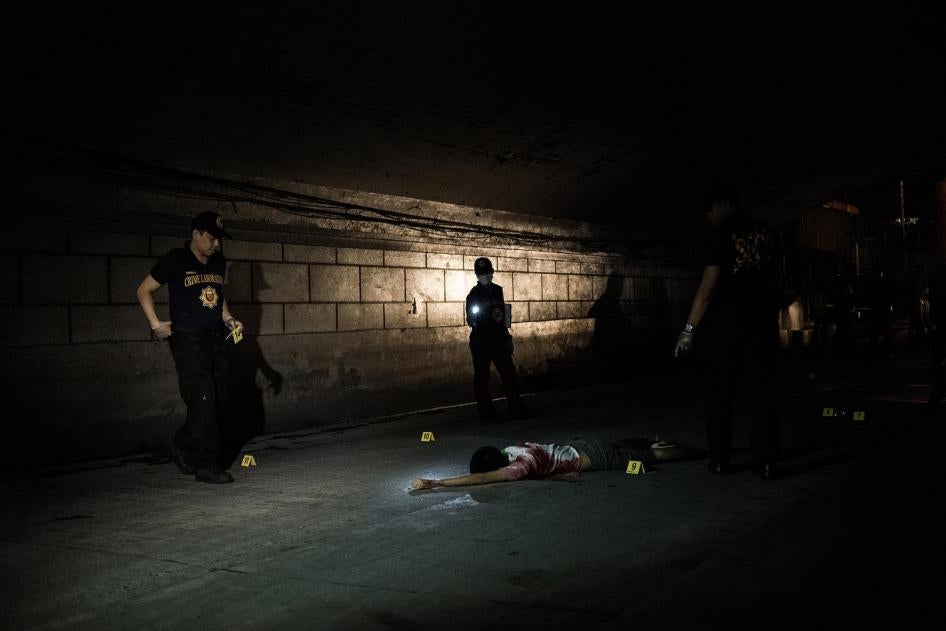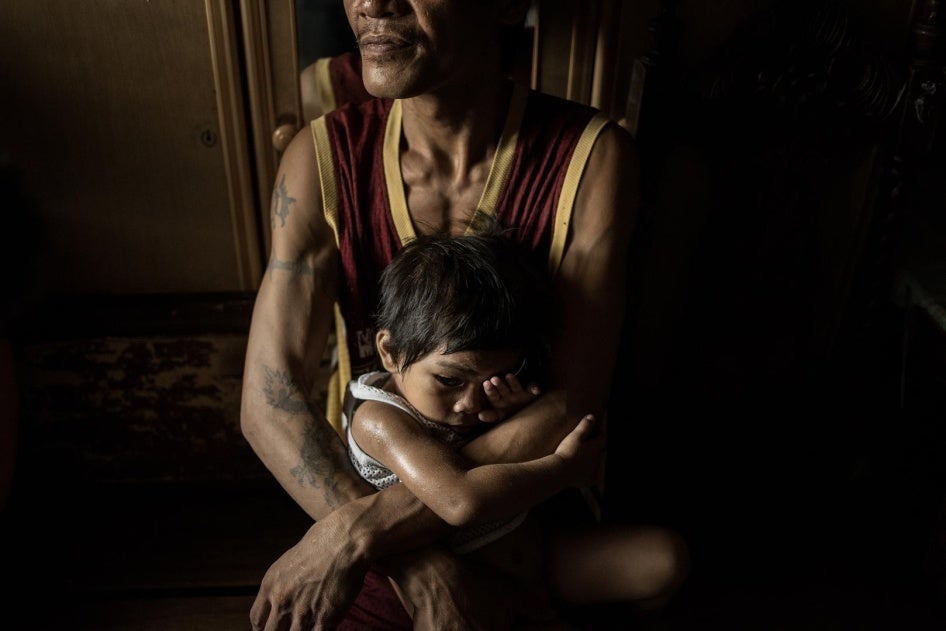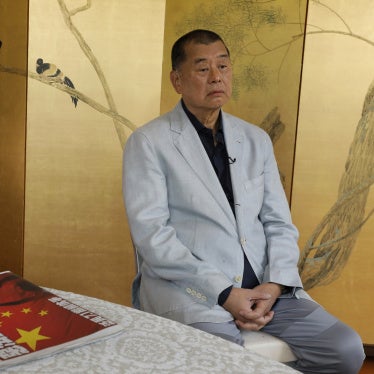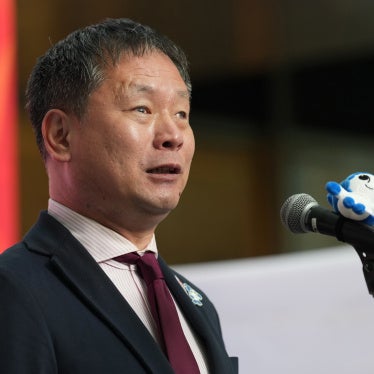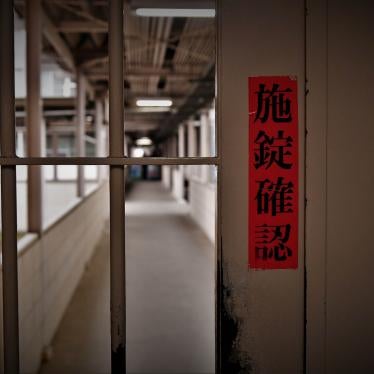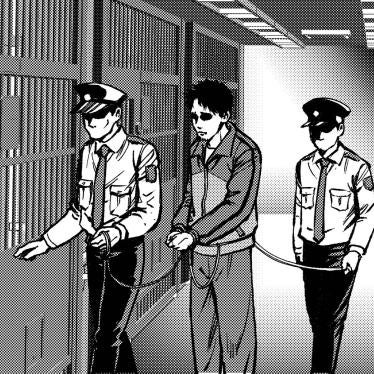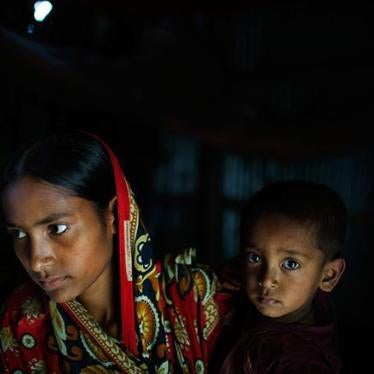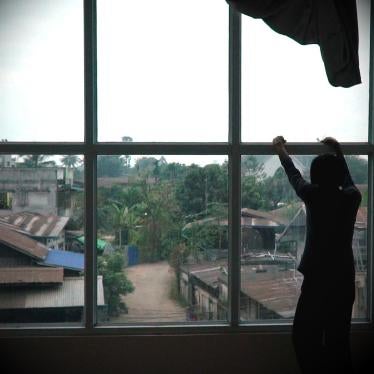(マニラ) - フィリピン国家警察は7,000人超の犠牲者を出している「麻薬戦争」に関し、違法殺人を隠蔽するため証拠を偽造している、とヒューマン・ライツ・ウォッチは本日発表の報告書内で述べた。この麻薬取締キャンペーンの犠牲者の大半は、都市部の貧困層。ロドリゴ・ドゥテルテ比大統領や政府高官は、一連の殺害を扇動しており、その行為は人道に対する罪に該当しうる。
責任追及メカニズムを確保するため国連は、責任の所在を見極める独立国際調査委員会を速やかに設置すべきだ。
ヒューマン・ライツ・ウォッチ緊急対応部門ディレクターのピーター・ブッカーは、「フィリピンの『麻薬戦争』に対する我々の調査で判明したのは、違法薬物関連の被疑者を、警察が冷酷に殺害し続けていること、そして現場に違法薬物や銃を仕込んで、警察がそうした犯罪を隠蔽していることだった」と述べる。「一連の殺害事件でドゥテルテ大統領が果たしてきた役割に照らせば、大統領自身がこの数千人規模の犠牲に対する責任を負っているということに最終的にはなるだろう。」
報告書「殺しのライセンス:ドゥテルテ大統領の『麻薬戦争』におけるフィリピン国家警察による殺人」(全117ページ)は、比国家警察が日常的に違法薬物関連の被疑者を超法規的に殺害したうえで、自己防衛を不当に主張していることを明らかにした。警察官が銃や使用済みの弾薬、パック入りの違法薬物などを遺体に仕込み、薬物関係者と見せかけるのだ。殺害実行役の武装した覆面の者たちも、警察と密接に協力しているとみられ、殺害の大半は自警団や違法薬物の密売人同士によるものとする、政府の主張に疑問が投げかけられている。ヒューマン・ライツ・ウォッチが調査したいくつかの事例では、警察が被疑者の身柄を拘束した後に死亡したにもかかわらず、警察が「遺体で発見された」あるいは「死因調査中」と分類していた。これまで「麻薬戦争」での殺人事件に関し、しっかりした訴追が一切ないだけでなく、まっとうな捜査が行われた件さえない。
本報告書は、マニラ首都圏の遺族や目撃者28人、ならびにジャーナリストや人権活動家への聞き取り調査を中心にまとめられた。加えて殺害事件に関する警察発表も参照しているが、その内容は一貫してヒューマン・ライツ・ウォッチの現地調査結果と矛盾している。
2016年6月30日の就任以来、ドゥテルテ大統領ほか政府高官は、違法薬物の密売および使用に関与した個人を殺害する全国取締りキャンペーンを公然と支持してきた。一方で、違法な警察活動については否定したり、あるいは問題視しないでいる。たとえば8月6日に大統領は違法薬物密売人に対し次のように警告している。「私の命令はお前たちを撃ち殺せというものだ。人権なんか関係ない。私の言葉を信じた方が身のためだ。」大統領は警察による殺害の犠牲者数が急増していることを、彼が主導する「麻薬戦争」の「成功」の証として賞賛した。
ヒューマン・ライツ・ウォッチは、合計32人が犠牲になった24件の事件を調査・検証。こうした事件は、夜遅く、都市部のスラム街の路上や小屋の中で起きることが多い。目撃者たちはヒューマン・ライツ・ウォッチに対し、武装した襲撃者が小グループで活動していると証言した。典型的には黒い平服に身を包み、目出し帽風のかぶりものなどと、野球帽やヘルメットで覆面しているという。襲撃者たちは戸を叩いて中に押し入ってくる際に、身元を明かしたり逮捕状を示したりすることはない。家族は犠牲者が暴行される音や命乞いする声を聞いたと報告している。屋内や路上で瞬時に銃殺されることもあった。襲撃者が被疑者をどこかに連れ去った数分後に銃声が起こり、その後地元住民が遺体を見つける場合や、時に手を縛られたり、頭をプラスチックで包まれた状態で遺棄された遺体がほかの場所で見つかる場合もあった。事件発生現場の近くで警察官が周囲を封鎖することや、銃撃前には姿が見えないのに、事件後わずか数分で犯罪現場担当の特別捜査官が到着することも珍しくないと、地元住民らは話す。
前出のブッカー緊急対応部門ディレクターは、「違法薬物取締り作戦のもとで、ドゥテルテ大統領の求めに応えた比国家警察が、何千人ものフィリピン市民を殺害してきた」と指摘する。「被疑者殺害の多くは同じようなパターンで起きており、警察による人権侵害行為を示唆している。」
ドゥテルテ大統領はしばしば、自らの「麻薬戦争」を「麻薬王」や「麻薬密売人」を標的にしたものと語ってきた。しかしヒューマン・ライツ・ウォッチが調査した事例で犠牲となっているのは、身元を間違われた1名を除いて全員が貧困層の人びとで、多くは密売人ではなく使用者だった。そしてほぼ全員が失業者か、そうでなければ人力車の運転手やポーターなどの仕事をしながら、スラム街や違法居住地で暮らしていた。
フィリピン当局は、警察や「正体不明の武装した者」による「麻薬戦争」の殺害事件を真剣に捜査してこなかった。比国家警察は、計922件を「捜査終了事案」に分類しているが、これらの捜査の結果、加害者の逮捕・訴追に至ったと示す証拠はない。
1月30日に政府は、韓国人実業家が違法薬物取締り班の警察官により残虐に殺害された事件が明るみに出たことを受け、警察による麻薬取締り作戦を一時停止すると発表した。翌日ドゥテルテ大統領は、この措置で取締りキャンペーンに空いた穴をフィリピン軍が全面的に埋めるよう命令。2022年の任期終了まで違法薬物取締りキャンペーンの手を止めることはないと公言している。
ドゥテルテ大統領と政権幹部たちは、これら殺害で果たしてきた役割ついて、国内でその刑事責任を問われるか、海外の裁判所で訴えられる可能性がある。これまでのところ、大統領が特定の超法規的殺人を計画、または命令した証拠はないが、違法薬物取締りキャンペーンの一環として殺害を繰り返し求める言動が、殺人を法執行機関に促す行為に当たる可能性がある。違法薬物使用が疑われる個人に対する自警団的な暴力を一般市民に奨励する発言の数々も、犯罪の扇動とみなされる可能性がある。
大統領、政府高官など、不法な殺害に関与した個人はまた、人道に対する罪を問われる可能性もある。これは、一般市民に対する広範または組織的な攻撃に関与したとする重大犯罪だ。公然と標的にされた違法薬物関連の被疑者グループに対する大規模かつ組織的と見受けられる致命的な攻撃は、フィリピンも加盟する国際刑事裁判所の規定する人道に対する罪に該当しうる。
大統領としてドゥテルテ氏は、違法薬物の密売や使用を疑われた個人の超法規的処刑キャンペーンを停止するよう、国の治安部隊に正式な命令を出す法的責任を負っている。比国家捜査局とオンブズマン事務所は公平に殺害事件を調査したうえで、加害者全員の訴追を模索すべきだ。比議会は当該問題に関して本格的な公聴会を開き、これ以上の殺害を防止する措置を講じる必要がある。フィリピンの援助国は、殺害事件に関して意味のある捜査が行われるまで、比国家警察への援助をすべて中止すべきだ。加えて、より適切で効果的な地域社会型の「ハームリダクション」プログラムへの援助に切り替えることも検討すべきだろう。
ブッカー緊急対応部門ディレクターは、「ドゥテルテ大統領の『麻薬戦争』は、都市部の貧困層を狙った人道に対する罪、と言える」と指摘する。「これら殺害に終止符を打つのがフィリピンの人びとの怒りなのか、世界の圧力なのか、あるいは国際的な調査なのかはわからないが、いつの日か終わりを迎え、責任を負った人間たちに法の裁きが下されるだろう。」
Selected Accounts from the Report
On the afternoon of October 14, 2016, four masked gunmen stormed the Manila home of Paquito Mejos, a 53-year-old father of five who worked as an electrician on construction sites. An occasional user of shabu, a methamphetamine, Mejos had turned himself in to local authorities two days earlier after learning he was on a “watch list” of drug suspects. The gunmen asked for Mejos, who was napping upstairs. “When I saw them with their handguns going upstairs,” a relative said, “I told them, ‘But he has already surrendered to the authorities!’ They told me to shut up, or I would be next.”
Two gunshots rang out. Police investigators arrived moments later and were assisted by the gunmen. In their report, the police referred to Mejos as “a suspected drug pusher” who “pointed his gun [at the police] but the police officers were able to shoot him first hitting him on the body causing his instantaneous death.” They said a shabu packet was found along with a handgun. “But Paquito never had a gun,” said his relative. “And he did not have any shabu that day.”
A barangay (neighborhood) official told Rogie Sebastian, 32, to surrender to the police because he was on the “watch list” as a drug user. He had given up drug use months earlier, so did not go. Two weeks later, three armed masked men wearing bulletproof vests arrived at his home in Manila and handcuffed him. “I could hear Rogie begging for his life from outside the room,” a relative said. “We were crying and the other armed man threatened to kill us as well.” A neighbor said: “I heard the gunshots. There were also uniformed cops outside, they did not go inside the house. But the three killers in civilian clothes came and went on a motorcycle without any interference from the uniformed cops.”
Five masked, armed men broke into a house in Bulacan province where Oliver Dela Cruz, 43, was playing cards. A relative said: “[W]e could see him kneeling in a surrendering position. The men grabbed him and slammed him into a concrete wall several times, and then they threw him … outside. We saw the shooting, we were just there. Oliver’s face was bleeding from being hit, and he was begging them for mercy when he was shot.”
After the shooting of Ogie Sumangue, 19, in Manila, uniformed police showed Sumangue’s relatives his body in the house, and a .45-caliber handgun next to his body. Family members said that Sumangue could not afford and did not possess a gun and therefore could not possibly have attempted to shoot at the police. “He cannot even pay the rent,” a relative said. “His sister paid the rent for him.”
Six masked armed men burst into a Manila home where a small group, including several teenagers, were watching television. The men arrested and beat drug suspects Aljon Mesa and Jimboy Bolasa, and then took them away on motorcycles. A half-hour later, after hearing from a uniformed policeman, relatives rushed to a nearby bridge to find Aljon and Bolasa’s bodies, both with gunshot wounds to the head, their hands tied with cloth. The gunmen were still at the scene, while uniformed police cordoned off the area. The police report, headed “Found Bodies,” claims that a “concerned citizen” alerted the police to the presence of two dead bodies.
A week after Aljon Mesa’s killing, 10 police officers, some in civilian clothes, arrested his brother Danilo Mesa and took him to the local barangay office. That evening, masked, armed men abducted him from the barangay office; shortly afterwards, his body was found under a bridge a block away. His relatives said that his entire head had been wrapped in packing tape, and his hands had been tied behind his back. He had been shot execution-style through the mouth.
Relatives of Edward Sentorias, 34, a jobless father of three killed by the police in Manila, said they had no hope for an investigation of the police: “I saw one of the police go inside with an aluminum briefcase.… [He took] out the gun and some [shabu] sachets, and placed them there [by Sentorias’ body]. I went back to where I was, and was totally shocked. I couldn’t even complain. If we go complain, what is our chance against the authorities?”
